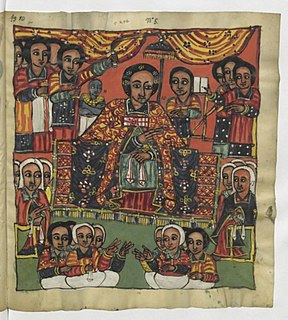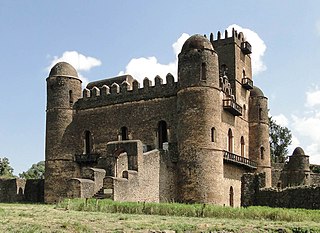
Fasilides, also known as Fasil, Basilide, or Basilides, was Emperor of Ethiopia from 1632 to his death on 18 October 1667, and a member of the Solomonic dynasty. His throne name was Alam Sagad.

Iyasu I, throne name Adyam Sagad, also known as Iyasu the Great, was Emperor of Ethiopia from 19 July 1682 until his death in 1706, and a member of the Solomonic dynasty. He was the son of Yohannes I and Empress Sabla Wangel.
Dawit III, throne name Adbar Sagad, also known as Dawit the Singer was Emperor of Ethiopia from 8 February 1716 to 18 May 1721, and a member of the Solomonic dynasty. He was the son of Iyasu I and his concubine Kedeste Krestos.

Iyoas I, throne name Adyam Sagad was Emperor of Ethiopia from 27 June 1755 to 7 May 1769, and a member of the Solomonic dynasty. He was the infant son of Iyasu II and Wubit, the daughter of an Oromo chieftain of the Karrayyu.
Yohannes II was Emperor of Ethiopia, and a member of the Solomonic dynasty. He was the son of Iyasu I, and brother of Emperors Tekle Haymanot I, Dawit III, and Bakaffa.
Tekle Haymanot II, throne name: Admas Sagad III was Emperor of Ethiopia from 18 October 1769 to 13 April 1777, and a member of the Solomonic dynasty. He was the son of Yohannes II by Woizero Sancheviyar, at the Imperial prison of Mount Wehni.

Tekle Giyorgis I, throne name Feqr Sagad, was Emperor of Ethiopia intermittently between 20 July 1779 and June 1800, and a member of the Solomonic dynasty. He was the youngest son of Yohannes II and Woizoro Sancheviyer, and the brother of Tekle Haymanot II.
Iyasu III was Emperor of Ethiopia from 16 February 1784 to 24 April 1788, and a member of the Solomonic dynasty. He was the son of Abeto Azequ, and the grandson of Iyasu II.
Hezqeyas was Emperor of Ethiopia from 26 July 1789 to January 1794, and a member of the Solomonic dynasty. He was the son of Iyasu III.
Egwale Seyon, throne name Newaya Sagad, was Emperor of Ethiopia from June 1801 to 12 June 1818, and a member of the Solomonic dynasty. He was the son of Hezqeyas.

Debre Libanos is an Ethiopian Orthodox Tewahedo monastery, lying northwest of Addis Ababa in the North Shewa Zone of the Oromia Region. It was founded in 1284 by Saint Tekle Haymanot as Debre Atsbo and was renamed as Debre Libanos in the 15th century. He meditated in a cave above the current monastery for 29 years. The monastery's chief abbot, called the Ichege, was the second most powerful official in the Ethiopian Church after the Abuna.
Gugsa of Yejju was a Ras of Begemder, and Inderase (regent) of the Emperor of Ethiopia. According to Nathaniel Pearce, he took the Christian name of Wolde Mikael. He was the son of Mersu Barentu and Kefey, the sister of Ras Aligaz. Both Bahru Zewde and Paul B. Henze consider his reign as Ras and Enderase as the peak of the Yejju Dynasty during the Zemene Mesafint.
Aligaz of Yejju was Ras of Begemder, and Inderase (regent) of the Emperor of Ethiopia. He was the son of Abba Seru Gwangul and brother of Ali I of Yejju; he became both Ras and Inderase following Ali's death. Aligaz had four sons: Dejazmach Birru, Dejazmach Gobeze, Dejazmach Faris, and Dejazmach Gojjee.

Mikael Sehul was a nobleman who ruled Ethiopia for a period of 25 years as regent of a series of weak emperors. He brought to an end the ancient Solomonic dynasty. He was also a Ras or governor of Tigray 1748–71 and again from 1772 until his death. He was a major political figure during the reign of Emperor Iyasu II and his successors until almost the time of his death.

Mentewab was Empress of Ethiopia, consort of Emperor Bakaffa, mother of Iyasu II and grandmother of Iyoas I. She was also known officially by her baptismal name of Walatta Giyorgis. Mentewab was a major political figure during the reigns of her son the Emperor Iyasu and grandson Iyoas. Empress Mentewab was also known by the honorific of Berhan Mogassa. This was to complement the honorific of her son Iyasu II, who was Berhan Seged.
The Battle of Debre Tabor was a conflict during the Zemene Mesafint in 1842 initiated by Dejazmach Wube Haile Maryam to overthrow Ras Ali II as Regent of the Emperor of Ethiopia and gain control of Ethiopia. This confused battle was won by Ras Ali, but at a steep price, and this victory failed to cement his position as the most powerful nobleman of his time.
Yeshaq Iyasu was a proclaimed Emperor of Ethiopia in 1685. He claimed to be the grandson of Susenyos by a son who had fled the Empire south of the Abay before Fasilides had imprisoned all of his male relatives on Wehni, and was supported by Qegnazmach Wale of Damot, and Tabdan the Hermit of Guondj. Although Yeshaq was supported in Gojjam, the center of his power was south of the Abay in Guduru.

The Zemene Mesafint was a period in Ethiopian history between the mid-18th and mid-19th centuries when the country was de facto divided within itself into several regions with no effective central authority. It was a period in which the Emperors from the Solomonic dynasty were reduced to little more than figureheads confined to the capital city of Gondar.
The Battle of the Dindar River was fought near the Dinder River in 1738, between the forces of the Ethiopian Emperor Iyasu II and the Sennar army under King Badi IV. The battle was a disaster for the Ethiopians and for Iyasu.

The Gondarine period was a period of Ethiopian history between the ascension of Emperor Fasilides in 1632 and a period of decentralization in 1769, known as the Zemene Mesafint.